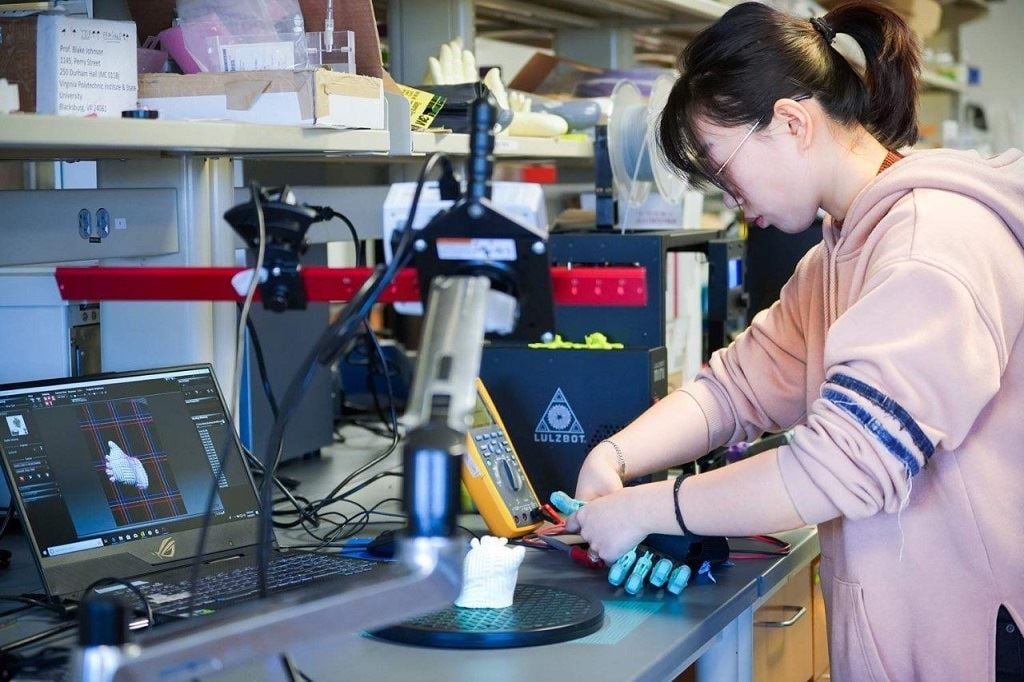![Yuxin Tong, an industrial and systems engineering graduate student, adjusts a 3D printed prosthetic. Tong was first author of a newly published research study about integrating electronic sensors in personalized 3D printed prosthetics. [Image: Linda Hazelwood/Virginia Tech]](https://fabbaloo.com/wp-content/uploads/2020/05/image1_img_5eb0995beda06.jpg)
3D printed prosthetic hands have come a long way.
Perhaps the most familiar design of 3D printed hand prostheses is the Raptor hand from e-NABLE. The design is relatively simple, intentionally: many of the hands are 3D printed and assembled by volunteers. They are low-cost and relatively easily available. It’s a fantastic initiative — but the hands are still rather simplistic.
One of the most common reasons amputees or others with limb deficiencies stop wearing their prosthetics is comfort. The right fit makes a huge difference. And all too often, that difference comes with a hefty price tag.
The highest-cost prosthetics are bionic devices made to precisely fit their wearer, designed for that person’s exact anatomy, and featuring levels of control. Low-cost prosthetics tend to be largely cosmetic, and may have some function to hold a cup or perhaps help play an instrument or write, but functionality is relatively limited.
With the advent of 3D printing, manufacturing is becoming more democratized — and that means more access to more ideas. 3D printed prosthetics are becoming wider-spread; indeed, we’re familiar with many wonderful initiatives and dedicated professionals working with 3D printed prostheses around the world.
The latest research published on enhancing 3D printed prosthetics comes out of Virginia Tech, where researchers are integrating electronic sensors for a better fit.
Virginia Tech explains:
“By integrating electronic sensors at the intersection between a prosthetic and the wearer’s tissue, the researchers can gather information related to prosthetic function and comfort, such as the pressure across wearer’s tissue, that can help improve further iterations of the these types of prosthetics.
The integration of materials within form-fitting regions of 3D-printed prosthetics via a conformal 3D printing technique, instead of manual integration after printing, could also pave the way for unique opportunities in matching the hardness of the wearer’s tissue and and integrating sensors at different locations across the form-fitting interface. Unlike traditional 3D printing that involves depositing material in a layer-by-layer fashion on a flat surface, conformal 3D printing allows for deposition of materials on curved surfaces and objects.”
Research began with a specific case study. A teenager, born with amniotic band syndrome that led to her right hand not developing past the knuckles, had had a mold made of her hand. The research team 3D scanned that mold to obtain data points to position sensors into the cavity the prosthetic, using conformal 3D printing.
![Teenager Josie Fraticelli and Virginia Tech assistant professor in industrial and systems engineering Blake Johnson in Durham Hall. [Image: Blake Johnson/Virginia Tech]](https://fabbaloo.com/wp-content/uploads/2020/05/image281291_img_5eb0995c649c2.jpg)
The bionic hand made in this process became the foundation upon which their recently published research was built to highlight the process for creating more comfortable, form-fitting prosthetics:
“They validated that the personalization of the prosthetic increased the contact between Fraticelli’s tissue and the prosthesis by nearly fourfold as compared to non-personalized devices.”
Many considerations remain in creating better prosthetics, but every piece of work undertaken can provide a step change for those who need them.
Via Virginia Tech











Healthcare 3D printing attempts to solve two problems that plague providing care: customization and cost.